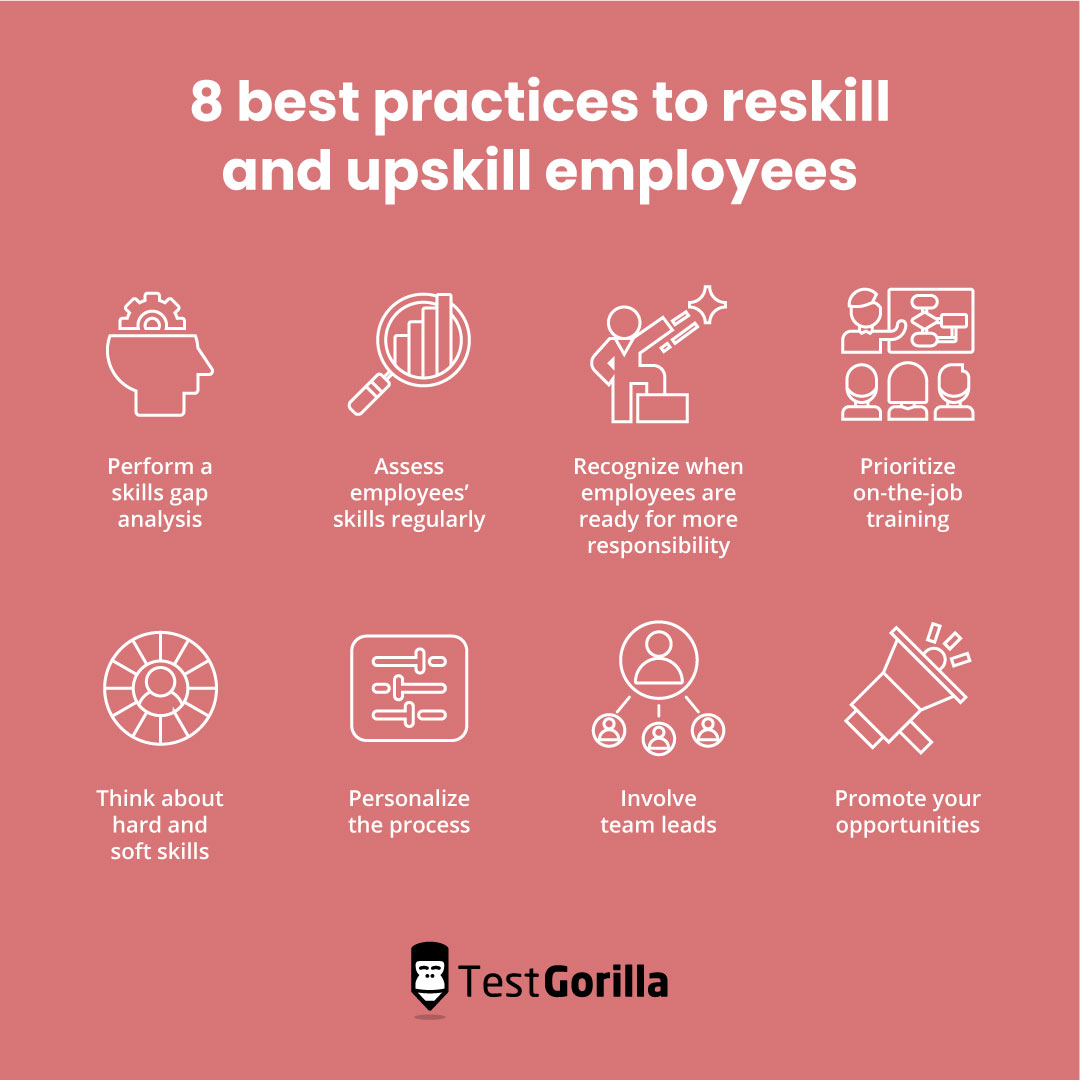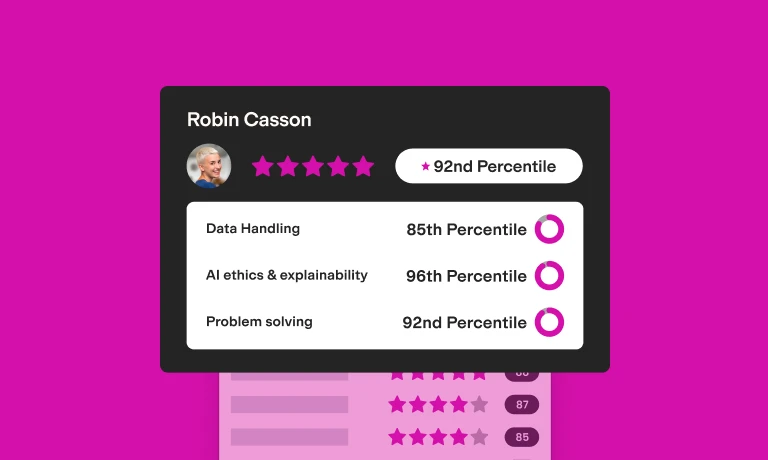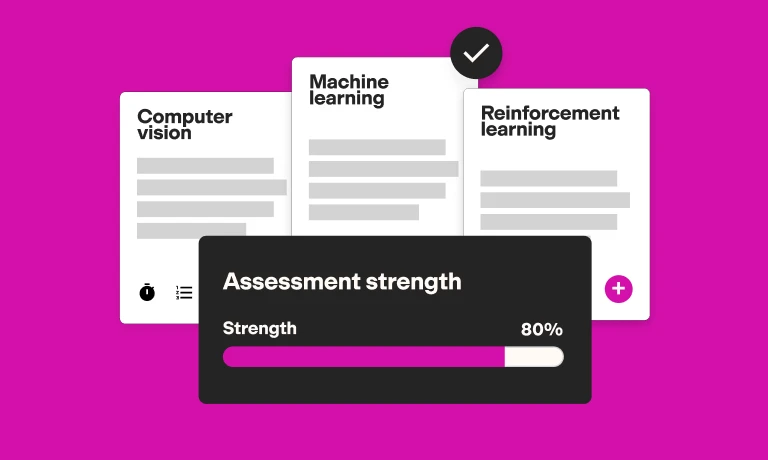Best practices to reskill and upskill employees
With an uncertain economic future ahead of us, you might think this isn’t the time to invest in reskilling and upskilling existing staff.
But when you reskill and upskill employees, you not only save money on recruiting new ones, you retain valuable staff, increase operational efficiency, and future-proof your business.
In this guide, we’ll discuss the benefits of upskilling and reskilling staff. We’ll walk you through our recommended best practices for reskilling and upskilling staff and give you practical tips on discovering what your employees are capable of.
Why should you upskill and reskill employees?
Upskilling and reskilling your employees increases morale, creates a more flexible workforce, and improves your company’s reputation. It also shows the people within and external to your organization that you value and look after your employees.
In our increasingly digitized and competitive world, it’s also becoming essential to equip your teams with the technical skills and knowledge they need to keep excelling at their jobs.
Let’s break it down further.
Modern employees demand it
Employees say having the opportunity to learn and grow is the number 1 factor that defines an exceptional work environment. This is a big increase from 2019 when it ranked as the 9th most important factor.
This desire is especially strong in younger generations. Millennials and Generation Z say that learning and development (L&D) opportunities were the second biggest reason they chose their current job. So if you want to attract and retain motivated, productive employees, you need to offer upskilling and reskilling resources.
It’s essential to stay competitive
By upskilling and reskilling your employees, you can prepare your organization for the future and gain a competitive advantage in otherwise stagnant markets.
For example, by helping employees develop the ability to use modern technology or cutting-edge software. Amazon is currently investing $1.2 billion USD in free training programs and college tuition for around 300,000 of its employees. One of its main areas of focus is to get young women to consider roles in tech through the use of role models and mentors.
Keeping employees up-to-date will help your organization stay relevant in tomorrow’s market. So we recommend you upskill and reskill employees to create a workforce that not only addresses your immediate business needs, but also future skills gaps as they emerge.
It’s more cost–effective than hiring
According to a report by the Financial Services Skills Commission (FSSC) and PwC, reskilling staff can create cost savings of around $60,000 per employee.
Just consider the cost and work involved in hiring. As well as the time and money it costs to check resumes, shortlist candidates, interview them, and conduct background checks, you also need to factor in onboarding and training.
And when you onboard new employees, you don’t just train them how to do their job, you teach them about company processes, protocols, tech, and systems.
By reskilling and upskilling existing employees you sidestep these costs and improve ROI on hiring. You also create a culture of continuous development, resulting in a more flexible, engaged workforce who are willing to learn new skills and processes. This should also positively impact on retention, which further boosts hiring ROI.
Want to get more value from your recruitment?
Our complete blueprint will provide the tips, strategies, and insights you need to maximize your recruitment ROI.
It lets you retain and reward talent
When an employee leaves, you lose the knowledge they’ve built up over months or years of the inner workings and culture of your organization. Even the best-designed onboarding program can’t replicate this. So by retaining talent, you’ll be able to keep this valuable asset inside your business.
Rewarding your employees with upskilling and reskilling programs and internal promotions also increases job satisfaction. You’ll be able to hang on to your most knowledgeable and skilled talent, and they can pass what they know to new employees.
It improves operational efficiency
Reskilled and upskilled employees with a broad knowledge of different areas of your business are a significant asset to any business. You can utilize these multi-skilled employees across projects, teams, and departments. They’ll bring you better, more diverse insights and can weigh in on different issues to help your company operate more efficiently.
Low employee engagement means lower efficiency. In fact, employee disengagement costs the global economy $7.8 trillion per year. Upskilling and reskilling employees demonstrates that you value them, resulting in higher engagement and operational efficiency.
It lets you prepare for automation and digitization
During the pandemic, companies had no choice but to switch from traditional to digital systems. This led to a sharp rise in the development of new apps, systems, and software, with no signs of slowing down. To prepare for this digitized future, you need to upskill your team to use this technology.
Although automation is replacing many jobs, it also offers an opportunity for reskilling your workforce. If part, or all, of an employee’s role is no longer needed, then it’s in your best interest to retain and retrain them with skills that suit your business needs.
8 best practices to reskill and upskill employees
If you’re planning reskill and upskill opportunities for your employees, think beyond budgets and timelines. You need to consider what skills your teams need to take your business forward and how to deliver them. Here are our recommendations for eight best practices for successful re and upskilling.
1. Perform a skills gap analysis
Find out what skills you actually need from staff by performing a skills gap analysis – focusing on the skills required for particular roles.
This will let you tailor your training to employees’ individual needs and more efficiently distribute L&D resources.
Here’s how to get it done:
Clarify your business goals. Consider your organization’s current and future business strategy and what you want to achieve now and long term.
Identify the skills you need to achieve these goals. Think about job descriptions, company values, and the business goals you identified earlier, and ask team members which skills they think they lack.
Internally measure skills. Use skills tests to assess your employees current skills, and perform a Strengths, Weaknesses, Opportunities, and Threats (SWOT) analysis.
Identify skills ga****ps. For example, create a ranking system where you can measure individual employees’ skills from 1 (poor) to 10 (exceptional).
Create a plan to address the gaps. Map out how to address the gaps you have found using mentorship, training, and other resources.
A well-performed skills gap analysis will allow you to upskill or reskill employees to your benefit.
2. Assess employees’ skills regularly
Skills assessment is for life, not just job candidates and new recruits. The more regularly you assess employees’ skills, the better. While many businesses conduct employee assessments annually, consider implementing several evaluations throughout the year.
The more often you hold these sessions the more normalized and informal they become. How often exactly will be determined by your business needs and schedule but they could take place quarterly, monthly, or even weekly.
Rather than waiting an entire year, you can track goal progress and give feedback as issues arise. As a result, employees feel more comfortable getting feedback about themselves, alleviating some of the pressure. Plus, you see the benefits of upskilling and reskilling sooner rather than later.
3. Recognize when employees are ready for more responsibility
There’s no point reskilling somebody who’s not ready for more responsibility. Here are some tell-tale signs that your employees are ready to level up:
Ingenuity and initiative. If an employee actively looks for solutions to problems, without you even asking them to, it shows they care about the work they’re doing and are motivated to exceed expectations.
Prioritization and deadline management. Taking on new responsibilities demands strong time management skills. Also, the employee will need to be able to stay on top of current duties whilst incorporating new ones into their workflow.
Drive for self-improvement. Is there a particular member of the team who’s constantly looking for ways to improve their processes or the quality of their work? That’s the person you want to invest in upskilling and reskilling.
Accountability. Employees who are accountable for their actions and receive criticism well are demonstrating they can learn new skills. You want to choose employees that worry less about making mistakes and more about how they can improve.
Strong performance reviews. Your employee may be ready for more if they’ve been sticking to their KPIs in recent reviews. If they can nail their current responsibilities, they’re almost certainly ready for more.
Being the person everyone turns to. If other teammates are always going to one particular employee for answers to their questions this is a sign that the person is ready to learn new skills.
4. Prioritize on-the-job training
Although external courses, events, and qualifications have their place, there’s no replacing the firsthand experience of learning in the workplace. Let’s face it – most people don’t like homework.
Here are five ways to provide on-the-job training:
Shadowing. You can have an employee learn how a team member works by watching what they do and gradually getting more involved.
Mentoring. A more experienced person (often – but not necessarily – older) can share their skills with a less experienced person. Or there’s reverse mentoring, where a younger person helps a mature employee upskill to new technologies.
Peer coaching. Peers can coach colleagues to help them develop the skills they need to grow. Peer-to-peer coaching creates a safe space where employees can experiment and be guided instead of directed or supervised.
Instructor-led. In-person or online workshops or lessons at work allow teams to ask questions and get immediate feedback, collaborate with their co-workers, and discuss the skills they’re learning.
Role swapping. Employees rotate between different roles to obtain new experiences and skills. After gaining this experience, employees can either return to their original position or grow into a new one.
5. Think about hard and soft skills
The main difference between hard skills and soft skills is how employees gain them and put them to use in the workplace. Hard skills come from education or specific training. They include technical knowledge like how to use machines or software.
Soft skills are more like personality traits that you’ve spent your whole (professional and personal) life developing. They involve how you manage your time, communicate with other people, or how you deal with conflict.
Traditionally speaking, hard skills have been seen as the be-all-and-end-all of upskilling and reskilling, but attitudes are changing. Soft skills are increasingly seen as distinct, vital, and teachable traits that need attention in the modern workplace.
In our 2022 State of Skills-Based Hiring report, a clear majority of hiring managers say they believe that testing for soft skills will be crucial to finding successful candidates over the next five years. In fact, the global soft skills training market is predicted to be worth $47.16 billion by 2027.
6. Personalize the process
To increase employee buy-in and productivity make sure your upskilling and reskilling efforts are as personalized as possible. Learning styles differ, and the skills that each worker needs vary based on their current situation.
When developing reskilling and upskilling programs for your team consider grouping them into categories. You can divide them by:
Department e.g. production, R&D, sales, marketing, human resources, or accounting.
Role e.g. administrative assistant, marketing manager, software engineer, or sales rep.
Work mode e.g. office, remote, or hybrid.
Location e.g. London office, or Los Angeles office.
Time at the company e.g. onboarding employees, recent employees, or veteran employees.
It’s also important to consider each employee’s natural talents and interests. Take the time to survey this data and you can come up with L&D opportunities that are not only right for people but will motivate them to upskill and reskill.
7. Involve team leads
Don’t leave mid-level managers or supervisors out of the process. They can contribute valuable information when you’re creating employee upskilling and reskilling programs. Team leads have massive insight into roles and responsibilities, day-to-day operations, and the employees who are in charge of them.
They know the team and have first-hand experience with employee performance. If they have one-on-ones with your employees, these are opportunities to identify skill gaps. Plus, by identifying the reskilling and upskilling needs and goals of different people, departments, or teams, managers can help you create your L&D programs.
8. Promote your opportunities
To drive awareness and participation, communicate your program to leadership teams throughout the organization. Be sure to explain how the training can benefit not only their team but also themselves.
It’s crucial to be transparent and open to feedback when communicating about available upskilling and reskilling programs. That way, you’re being honest about what’s on offer and can improve and grow the program.
Here are some ways you can effectively communicate your schemes and increase participation:
Plan a yearlong campaign that showcases your upskill and reskill programs and highlights success stories.
Theme each month around specific topics or skills.
Working with HR or the communications department you can create and share engaging and relevant promotional content for sharing internally.
Tweak this content and share it externally to strengthen your brand and attract new hires.
Create a spreadsheet that organizes all these communications with an editorial calendar of when and how new training will be available.
Set quarterly goals that target specific upskill and reskill programs.
The best insights on HR and recruitment, delivered to your inbox.
Biweekly updates. No spam. Unsubscribe any time.
Invest in reskilling and upskilling employees for future success
Investing in reskilling and upskilling your team means higher staff retention and money saved. Also, improved efficiency and increased ROI.
When planning an L&D program, remember these best practices:
Regularly assess employees’ skills and perform skills-gap analyses
Recognize when employees are ready for more responsibility and personalize the reskilling and upskilling process
Think about both hard and soft skills and prioritize on-the-job training
Involve peers and team leaders, and work with leadership to promote your program
But while creating internal opportunities for upskilling and reskilling is important, you should also try to hire for upskill potential. Using skills-based testing helps you pinpoint exactly where new hires excel and where there might be untapped potential waiting to be discovered.
Want to take employee engagement, efficiency, and flexibility to the next level?
Skills-based hiring lets you assess employee skill gaps and plan the perfect upskill or reskill program.
Download the 2022 State of Skills-based hiring report to learn more.
Related posts
You've scrolled this far
Why not try TestGorilla for free, and see what happens when you put skills first.

















